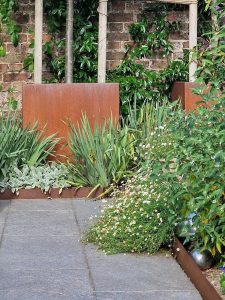Cor-ten steel in garden design has taken the landscaping world by storm. It’s everywhere, from modern urban gardens to grand showpieces at the Chelsea Flower Show and it is a product I have used in many gardens. But is it here to stay, or just a fleeting trend? Let’s explore its benefits, challenges, and whether it truly stands up to weathering.Is Cor-ten steel in Garden Design long lasting or just a fad?
Versatile Cor-ten is so versatile being used here for a raised bed
The Aesthetic Appeal of Cor-ten Steel
One of the biggest draws of Cor-ten steel is its rich, rusted appearance. The warm, earthy tones create a striking contrast against lush greenery. It’s particularly stunning when used to highlight perennials like ornamental grasses, geums, salvias and echinacea Over time, though, the orange-brown patina deepens, eventually becoming a very dark brown. Some love this evolution, while others prefer the fresh, rusted look.
Durability and Weather Resistance
Cor-ten steel is designed to withstand the elements. Unlike regular steel, it forms a protective layer of rust that prevents deeper corrosion. This makes it a long-lasting material, perfect for garden edging, raised beds, and statement sculptures. However, it does require some maintenance. For maximum longevity, treating the back of the panels with metal paint is essential. This prevents unseen moisture damage, ensuring the steel remains structurally sound for years. This is something that many landscapers over look so make sure its done if you are having it installed!
A Chelsea Flower Show Favourite
Cor-ten steel has been a regular feature at the Chelsea Flower Show, often used by top garden designers to create dramatic, contemporary landscapes. Designers like Andy Sturgeon and Tom Stuart-Smith frequently incorporate it into their projects. Its versatility allows it to blend seamlessly with both modern and naturalistic planting schemes.
Garden Designer Andy Sturgeon used Cor-ten steel monoliths in a “Chelsea” Garden
How Versatile is Cor-ten Steel?
Cor-ten steel isn’t just for edging and planters. It can be used for pergolas, water features, fire pits, and even retaining walls. It pairs beautifully with materials like wood, stone, and gravel. Whether in minimalist designs or wilder, nature-inspired gardens, Cor-ten adds depth and character. The fact that this steel can be manipulated means it is great for making curved raised beds or retaining walls but I would definitely use block work behind it for longevity

Cor- ten planters and edging I used in a Garden in Brighton, Sussex
Are There Alternative Metals?
While Cor-ten is popular, other metal options exist. Galvanized steel offers a sleek, industrial feel without the rust. Stainless steel provides a contemporary, polished look but is more expensive. Aluminum is lightweight and corrosion-resistant but lacks the rugged appeal of Cor-ten. Each has its pros and cons, but they simply don’t have the ‘natural’ appearence that cor-ten steel offers
My Thoughts: Trend or Timeless?
Cor-ten steel in garden design seems to be more than just a passing fad. Its durability, adaptability, and distinctive aesthetic make it a staple in modern landscaping. However, it requires thoughtful use and maintenance to ensure it looks its best for years. I, personally, wouldn’t use it in shaded areas as it seems to ‘weather’ really quickly becoming very dark. However, if you love its evolving patina and structural strength, it’s a fantastic investment for your garden.
If you are looking to use Cor-ten in your garden and don’t know where to start feel free to contact Purelyplanting for friendly, professional advice

Recent Comments